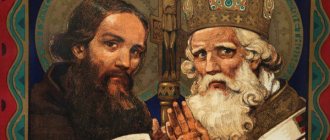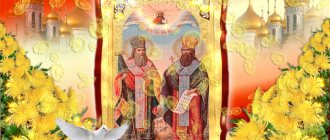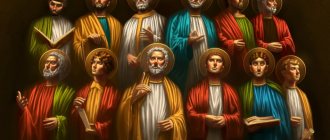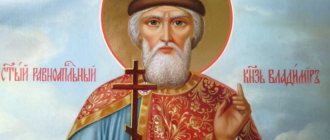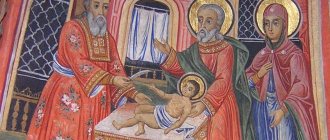The alphabet is also a set of symbols used to convey written speech in a certain language, otherwise the alphabet; and a book for mastering the alphabet and the basics of written literacy.
Wikimedia Commons (CC BY 1.0)
Therefore, answering the question of what the first Slavic alphabet was called, we should talk about both the symbolic corpus and the book.
Creators
The alphabet was created by Cyril and Methodius (Fig. 1), brother scientists from what is now Greek Thessalonica in the north of the Byzantine Empire. In the Old Russian language, Thessalonica was called Thessalonica.
Important! Kirill originally bore the name Konstantin. He received his name known today at the very end of his life when he was tonsured a monk.
The father of the scientists Cyril and Methodius came from a noble family. Methodius held the high government position of strategos, but later became a monk. Konstantin followed the spiritual path from the very beginning. He mastered all the ancient arts and spoke several foreign languages. Slavic was his native language.
Rice. 1. Cyril and Methodius
Runic alphabet in Ancient Rus'
The ancient Slavs used the runic alphabet not only for writing, it was used when performing rituals. Runes were applied to the body as amulets, embroidered on clothes and depicted on dwellings. It was believed that they could strengthen or soften certain character traits.
In terms of design and interpretation, the Slavic runes are somewhat similar to the German Futhark alphabet. Both are based on the Northern Italic Alpine alphabet.
The runic alphabet has 144 characters , each of which denoted a separate letter, word or whole action. Scientists suggest that in total the Slavs used several million runes. To date, 18 runes have been deciphered - they were the most common. Their names:
- Alatyr;
- World;
- Chernobog;
- Rainbow;
- Need;
- Steal;
- Treba;
- Force;
- Wind;
- Bereginya;
- Oud;
- Lelya;
- Rock;
- Support;
- Dazhdbog;
- Perun;
- Eat;
- Source.
When writing texts, the runes were placed in a row of 16 characters, for a total of 9 rows. There was also an option with writing in 32 and 64 characters, where every second character reinforced the meaning of the previous one.
Prerequisites for the creation of Slavic writing
In the IX-X centuries. there was a large Slavic state of Great Moravia (Fig. 2). During its heyday, Moravia included the territories of modern Czech Republic, Slovakia, Hungary, southern Poland, western Ukraine and eastern Germany.
The main enemy of Moravia was the East Frankish Kingdom. There was a threat of dividing the country between the Franks and Bulgarians.
The Great Moravian prince Rostislav sent envoys to Pope Nicholas I to reduce the influence of his main enemy in the west and get rid of the threat of division of the state. The prince asked to be given teachers to train Moravian priests instead of the Bavarian ones, whom he had expelled from the country. However, Pope Nicholas refused to fulfill his request. Having received no support from Rome, Rostislav sent an embassy to Constantinople. Emperor Michael did not refuse help, and the learned men Constantine and Methodius went to Moravia with their students.
Rice. 2. Territory of Great Moravia
Missionary politician
This medieval inseparability of spiritual, religious tasks and state affairs looks bizarre these days. But even for it one can find some analogy in the modern world order. And today, superpowers, the newest empires, base their influence not only on military and economic power. There is always an ideological component, an ideology that is “exported” to other countries. For the Soviet Union it was communism. For the United States, it is a liberal democracy. Some people accept exported ideas peacefully, while others have to resort to bombing.
For Byzantium, Christianity was the doctrine. The strengthening and spread of Orthodoxy was perceived by the imperial authorities as a primary state task. Therefore, as a modern researcher of the Cyril and Methodius heritage writes A.-E. Tahiaos, “a diplomat who entered into negotiations with enemies or “barbarians,” was always accompanied by a missionary.” Constantine was such a missionary. That is why it is so difficult to separate his actual educational activities from his political ones. Just before his death, he symbolically resigned from public service and became a monk. “I am no longer a servant of the king or anyone else on earth; Only God Almighty was and will be forever,” Kirill will now write.
His life tells about his Arab and Khazar mission, about tricky questions and witty and deep answers. Muslims asked him about the Trinity, how Christians could worship “many gods,” and why, instead of resisting evil, they strengthened the army. Khazar Jews disputed the Incarnation and blamed Christians for non-compliance with Old Testament regulations. Konstantin's answers - bright, figurative and brief - if they did not convince all opponents, then, in any case, they delivered a polemical victory, leading those listening to admiration.
Moravian Mission of Constantine and Methodius
Constantine, his brother Methodius and his students created a new alphabet and began translating liturgical books into the Slavic language. First of all, those books were translated, without which not a single church service was complete:
- The Gospel
(Fig. 3) is the story of the birth, life, death on the cross and resurrection of Christ; - Apostle
- a book telling about the acts and teachings of the holy apostles; - Psalter
- a collection of church hymns; - Octoechos
is a liturgical book.
The missionaries stayed in Moravia for three years. They were engaged not only in translations of church books, but also in training priests to read, write and conduct church services in the Slavic language.
Important! The activities of Thessalonica scientists displeased the Pope. At that time, it was believed that church services should be conducted only in Greek, Hebrew or Latin. The remaining languages were not intended for church services. Constantine and Methodius were recognized as heretics and summoned to the pope.
Short story
The need to compile the Slavic alphabet was realized primarily in the educated circles of Byzantium. It was in the interests of the empire to introduce the Slavic population of the provinces into the circle of Byzantine culture.
For this purpose, attempts were made to create a Slavic alphabet, but they were not successful until the work of the Slavic enlighteners, whose names are associated with the origin of the Glagolitic and Cyrillic alphabet.
Cyril, nicknamed the Philosopher for his learning, began working on compiling the Slavic alphabet in his monastic retreat on Mount Olympus (in Asia Minor) in the 850s. He had the following personal prerequisites for successful work in this direction:
- Place of his birth. Many Slavs lived in Thessalonica, the capital of Macedonia, so Saint Cyril knew the Slavic language well.
- The education received under the guidance of the future Patriarch Photius, who was the greatest philologist of his time, determined Cyril the Philosopher's interest in working with languages, and also gave him the ability to succeed in this.
- Active missionary activity: Saint Cyril participated in several missionary enterprises. He was convinced that peoples newly converting to Christianity needed to have the text of the Holy Scriptures and liturgical texts in their native language.
During the Khazar mission of 860−861, Cyril the Philosopher studied the Hebrew language and writing, as well as the books of the Holy Scriptures written in Syriac. Acquaintance with ancient languages gave him examples of alphabets other than Greek and helped him compile the Slavic alphabet.
The entrustment of the Moravian mission to the brothers Cyril and Methodius in 863 prompted the brothers to bring the creation of the alphabet to completion. Even in Constantinople, before leaving for Moravia, the enlighteners completed work on the alphabet. The appearance of the first book translated into Slavic also dates back to this time.
Difficulties in the formation of Slavic writing
In 868, when the brothers arrived in Rome, Adrian II was pope. Constantine and Methodius tried to gain support in the fight against the German bishops and presented the relics of St. Clement to the pope. Adrian II gave permission to conduct the service in his native Slavic language. Soon Konstantin fell ill. He took monastic orders and began to be called Cyril. Shortly before his death, he asked his brother not to return to the monastery, but to continue the work they had started together.
Changes took place in Great Moravia. Prince Rostislav died in a German prison, and his nephew Svyatopolk could not resist East Frankish influence. German bishops did their best to prevent church services from being conducted in the Slavic language.
Rice. 3. Zograf Gospel in Glagolitic
After returning to Moravia, Methodius was exiled to the Reichenau monastery. Three years later, Pope John VIII forced Methodius to be released from the monastery, but he also forbade conducting services in the “barbaric Slavic” language. When Methodius died, many Slavic teachers were executed or expelled from Moravia. The mission of the learned brothers was not successful during their lifetime, but it influenced subsequent historical events in Europe.
"Nobody else"
The Khazar mission was preceded by events that greatly changed the internal structure of the Solun brothers. At the end of the 50s of the 9th century, both Constantine, a successful scientist and polemicist, and Methodius, shortly before appointed archon (head) of the province, retired from the world and led a solitary ascetic lifestyle for several years. Methodius even takes monastic vows. The brothers were already distinguished by their piety from an early age, and the thought of monasticism was not alien to them; however, there were probably external reasons for such a drastic change: a change in the political situation or the personal sympathies of those in power. However, the lives are silent about this.
But the bustle of the world receded for a while. Already in 860, the Khazar Kagan decided to organize an “interreligious” dispute, in which Christians had to defend the truth of their faith before Jews and Muslims. According to the life, the Khazars were ready to accept Christianity if the Byzantine polemicists “won the upper hand in disputes with the Jews and Saracens.” They found Constantine again, and the emperor personally admonished him with the words: “Go, Philosopher, to these people and talk about the Holy Trinity with Her help. No one else can take on this with dignity.” On the trip, Konstantin took his older brother as his assistant.
The negotiations ended generally successfully, although the Khazar state did not become Christian, the Kagan allowed those who wished to be baptized. There were also political successes. We should pay attention to an important incidental event. On the way, the Byzantine delegation stopped in Crimea, where near modern Sevastopol (ancient Chersonesos) Constantine found the relics of the ancient saint Pope Clement. Subsequently, the brothers will transfer the relics of St. Clement to Rome, which will further win over Pope Adrian. It is with Cyril and Methodius that the Slavs begin their special veneration of Saint Clement - let us remember the majestic church in his honor in Moscow not far from the Tretyakov Gallery.
Cyrillic and Glagolitic
The question of the seniority of the origin of the Glagolitic and Cyrillic alphabet remains open to this day.
There is an assumption that Constantine created the Glagolitic alphabet, and the Cyrillic alphabet is its improved version, created by Constantine later.
The theory in which Constantine created the Glagolitic alphabet has the most adherents. The Cyrillic alphabet was supposedly created by Constantine's student Kliment Ohridski.
Important! The creation of writing required a detailed study of the phonetic composition of the language. Konstantin managed to identify all the significant sounds of the Slavic language and give each a unique letter designation.
The translation of church books and the Gospel required a special approach to the language of the Moravian people. The Greek language had incomparably more religious terms than the language of the Slavs; many words had no analogues in the translated language. The great merit of Constantine and his associates is that he was able to create the Old Slavic language - the first literary language of the Slavs.
This language is based on the dialects of southern peoples. Old Slavonic is also known as Old Church Slavonic. Its development did not stand still, and Old Church Slavonic was transformed into Church Slavonic.
Important! Church Slavonic remains the language of worship in many countries today: in Serbia, Ukraine, Russia, Ukraine, Poland, Montenegro.
Rice. 4. Prayer “Our Father” in Glagolitic
Glagolitic
The Glagolitic alphabet (Fig. 4) was used primarily by the southern and western Slavs. It differs from the Latin and Greek alphabet in its particular intricacy, which became the subject of sharp criticism from contemporaries. The names of the letters of the Glagolitic alphabet coincide with the Cyrillic ones, although they have different styles.
The early (rounded) style of Glagolitic letters is reminiscent of the Georgian ecclesiastical script Khutsuri, presumably created on the basis of the Armenian alphabet. Konstantin knew some eastern alphabets, so this coincidence is understandable. The later (angular) letterform was used until recently in Croatia.
Important! Today the Glagolitic alphabet remains in use only in some churches in Croatia.
Cyrillic
The Cyrillic alphabet completely borrowed the letter styles of the Greek alphabet (24 letters). 19 letters were added to them, which indicate purely Slavic sounds of the language. Ksi, psi, fita and izhitsa are placed at the end of the alphabet (Fig. 5).
Each letter of the Cyrillic alphabet has its own name. The first letter is “az”, the second is “buki”, the third is “vedi”. If you read the names of the letters as text, you can decipher the following: “I lead the beeches, the verb is good - I know the letters, the word is good.”
The simple alphabet became widespread, including in Rus' after some time. Cyrillic became the alphabet of the Old Russian language.
Rice. 5. Cyrillic with borrowed Greek letters
In Russia, the Cyrillic alphabet has undergone many transformations to this day. In 1708-1711, Peter I carried out a reform of Russian writing. Some letters and superscripts have been eliminated. A civil script was introduced, replacing the statutory and semi-statutory ones. New letters “y” and “e” and “e” appeared, invented by Princess E. R. Dashkova. In 1918, the last writing reform was carried out, after which the alphabet acquired its modern form.
Important! Cyrillic is used in several Slavic and friendly countries: Ukraine, Belarus, Serbia, Mongolia, Kazakhstan and others. Small nations of Russia also use the Slavic alphabet.
The price of success
However, the activities of educators could not be limited only to scientific and translation research. It was necessary to teach the Slavs new letters, a new book language, a new worship. The transition to a new liturgical language was especially painful. It is not surprising that the Moravian clergy, who had previously followed German practice, reacted with hostility to the new trends. Even dogmatic arguments were put forward against the Slavic translation of services, the so-called trilingual heresy, as if one can only speak to God in “sacred” languages: Greek, Hebrew and Latin.
Dogmatics intertwined with politics, canon law with diplomacy and power ambitions - and Cyril and Methodius found themselves in the center of this tangle. The territory of Moravia was under the jurisdiction of the pope, and although the Western Church was not yet separated from the Eastern, the initiative of the Byzantine Emperor and the Patriarch of Constantinople (namely, this was the status of the mission) was still viewed with suspicion. The German clergy, closely associated with the secular authorities of Bavaria, saw in the brothers’ undertakings the implementation of Slavic separatism. And indeed, the Slavic princes, in addition to spiritual interests, also pursued state interests - their liturgical language and church independence would have significantly strengthened their position. Finally, the pope was in tense relations with Bavaria, and support for the revitalization of church life in Moravia against the “trilinguals” fit well into the general direction of his policy.
Political controversies cost the missionaries dearly. Due to the constant intrigues of the German clergy, Constantine and Methodius twice had to justify themselves to the Roman high priest. In 869, unable to withstand the overstrain, St. Cyril died (he was only 42 years old), and his work was continued by Methodius, who was ordained to the rank of bishop in Rome soon after. Methodius died in 885, having survived exile, insults and imprisonment that lasted several years.

